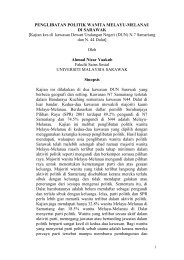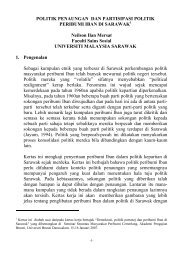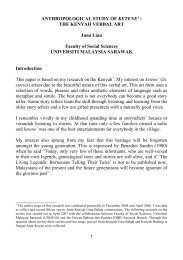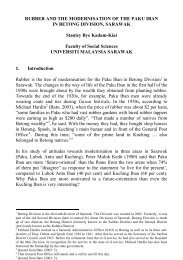OF SOUKHUAN AND LAOS Elena Gregoria Chai Chin Fern Faculty ...
OF SOUKHUAN AND LAOS Elena Gregoria Chai Chin Fern Faculty ...
OF SOUKHUAN AND LAOS Elena Gregoria Chai Chin Fern Faculty ...
You also want an ePaper? Increase the reach of your titles
YUMPU automatically turns print PDFs into web optimized ePapers that Google loves.
The smoldering wood was waved in a sweeping motion towards the direction of the<br />
kerng. That was done to direct the khuan into the fishing cage. Mae Thao then walked<br />
around the mango tree several times and then made her way home. The villagers who<br />
witnessed this did not utter a word to her. She continued to call the khuan back. The<br />
villagers would give way as she walked as they believed that any disturbance or<br />
obstruction would result in the khuan ‘held’ in the kerng, to flee again. When she<br />
reached the front gate of her house, she covered the kerng with a clean piece of cloth.<br />
Before stepping onto the staircase of the house, she asked loudly, “Has Bak Kok come<br />
back?” The mother and sisters of Kok answered simultaneously “Yes! He has already<br />
returned.” Then Mae Thao left the smoky wood behind, on the foot of the staircase<br />
and walked into the house. She went to Kok’s bedside, lifted the kerng, took the cloth<br />
away and ‘poured’ the khuan over Kok’s body. The rite then ended. As the word<br />
‘wan’ means ‘to find’, Wankhuan therefore is a generic term used to find the khuan<br />
which has been frightened off from the body. If one’s health does not improve within<br />
a few days of a Wankhuan, a more elaborate soukhuan rite will be performed. In this<br />
case study, Kok got well the next morning and everyone in the house thanked Mae<br />
Thao for finding Kok’s khuan back.<br />
The sornkhuan Ceremony<br />
In other villages, the Sornkhuan method is used (pers. comm. with Mae Thao). ‘Sorn’<br />
means ‘catch’, and therefore Sornkhuan means catching the khuan which has<br />
wondered away from the body. It is performed for the same purpose, for people who<br />
has fallen after an accident. Similar to Wankhuan, the kerng, this time filled with a<br />
handful of cooked sticky rice and a hard-boiled egg. Yet again, the person who<br />
performs such a task is an old person like Mae Thao (grandmother) or Pho Thao<br />
(grandfather). Upon reaching the place where the accident occured, Mae Thao or Pho<br />
Thao will try to capture the lost khuan as if catching fish in the river, simultaneously<br />
calling, “Ma yer khuan er! Ma yer!” After sometime, when the khuan is presumably<br />
caught, Mae Thao or Pho Thao will go back to the house and feed the sick person with<br />
the sticky rice and egg.<br />
It must be noted that an older person performs both khuan “finding” and khuan<br />
“catching” rites. Similarly, an older person summons the khuan to return in a<br />
soukhuan ceremony. This is because older people are believed to possess stronger<br />
khuan because of their age. Their khuan are stable and firmly attached, unlike the<br />
young. The younger a person is, the more vulnerable the khuan is and the tendency to<br />
lose the khuan when frightened, is high. The khuan of children under the age of ten<br />
are considered very weak.<br />
When a young child cries in the middle of his/her sleep, it is believed that his/her Mae<br />
Kaw, (his/her mother from a previous life) has returned to play with him/her. When<br />
the crying continues for several nights, it is said that Mae Kaw has brought him to a<br />
far away place and some of his khuan have gotten lost and could not return home. In<br />
- 13 -<br />
PDF Creator - PDF4Free v2.0<br />
http://www.pdf4free.com







